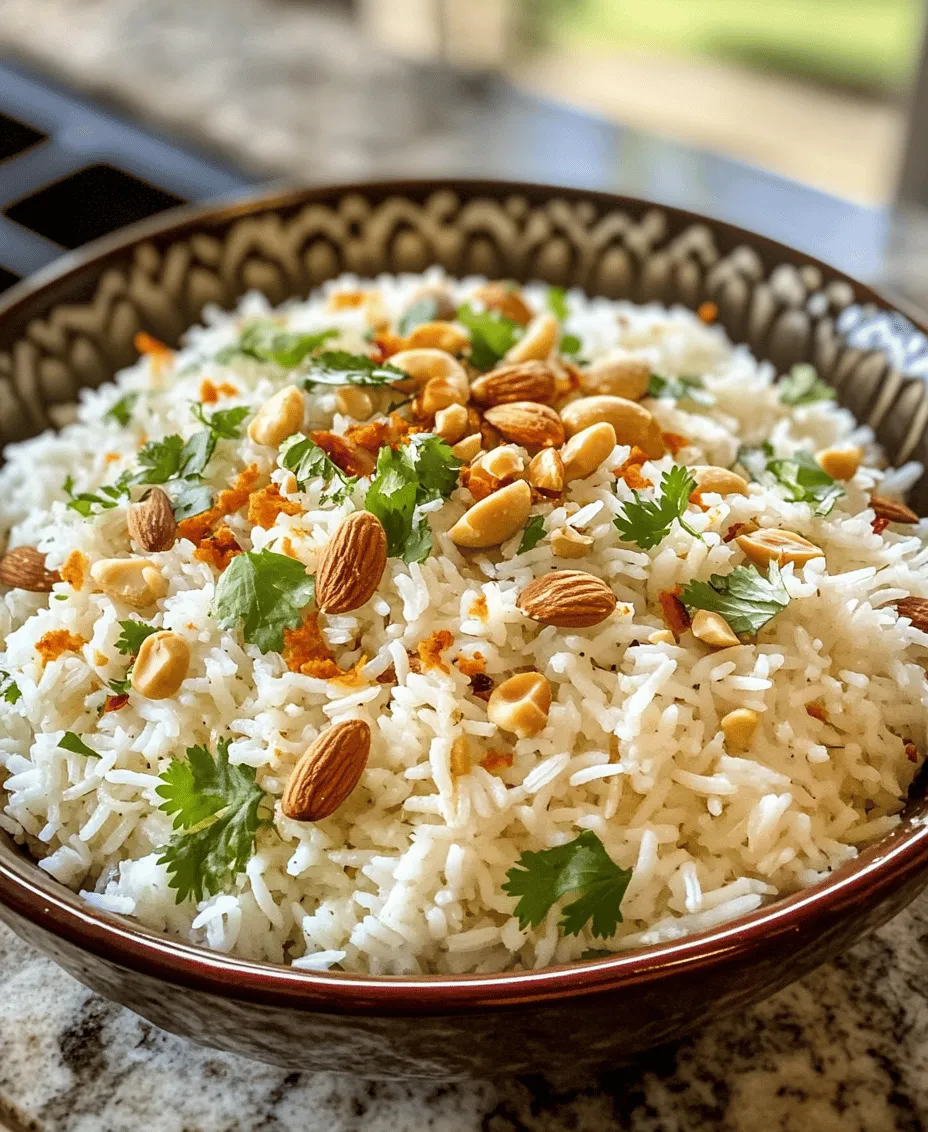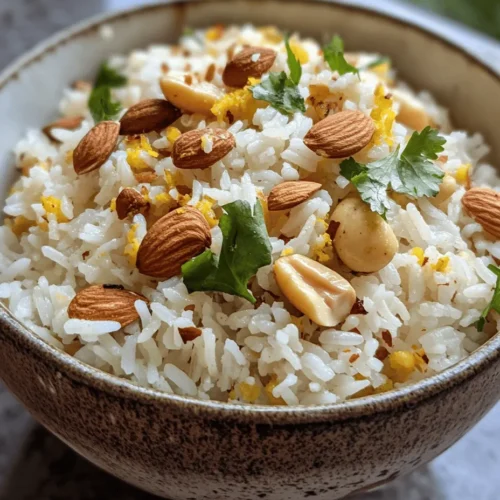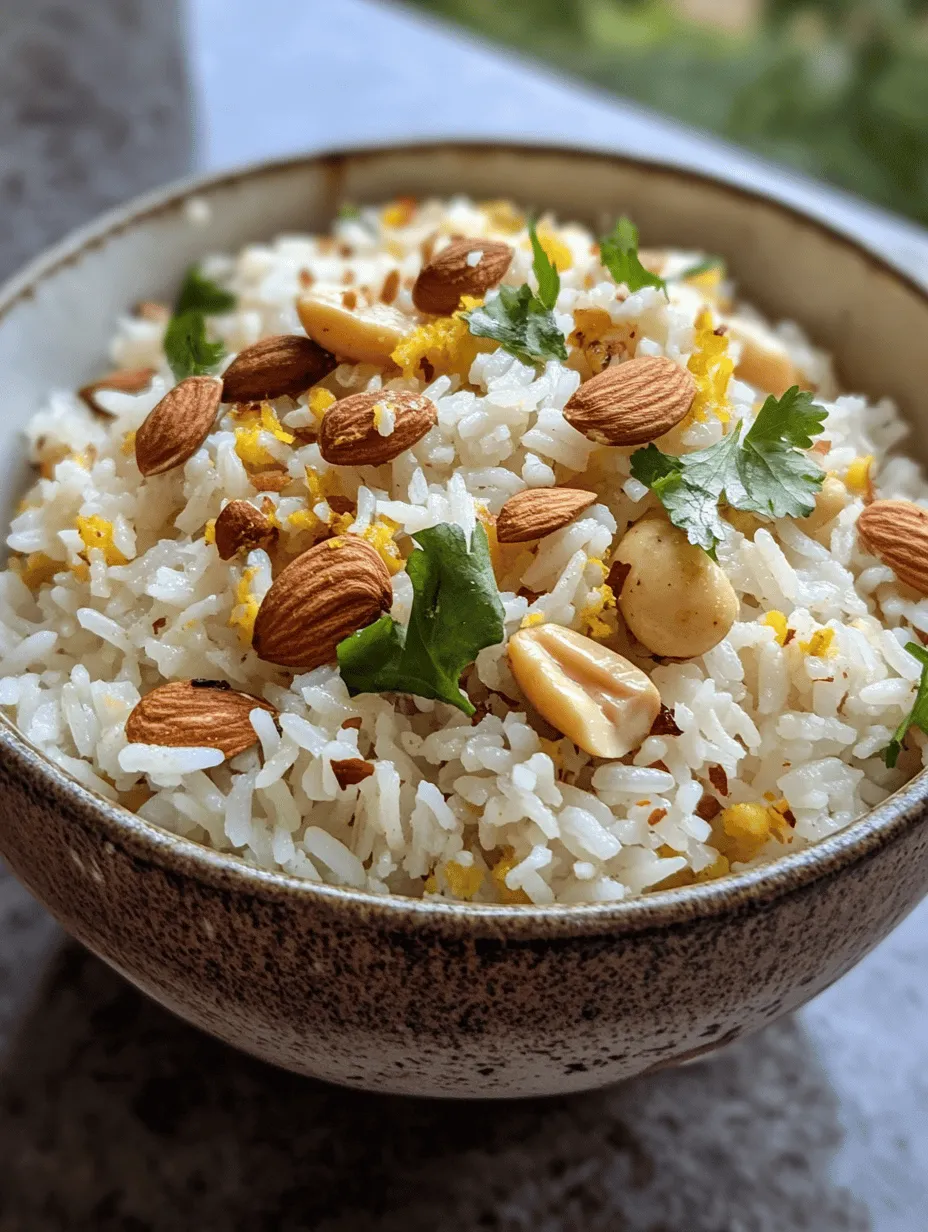Introduction
Roasted Rice with Nuts is a dish that beautifully marries the earthy flavors of grains with the crunch of nuts, resulting in a delightful culinary experience. This dish is not only appealing to the taste buds but also offers a wonderful texture that elevates any meal. Whether served as a side dish during family gatherings or as a centerpiece in meal prep, Roasted Rice with Nuts is incredibly versatile and can easily adapt to suit various occasions.
Incorporating nuts into your meals is a fantastic way to enhance both flavor and nutrition. Nuts are packed with healthy fats, protein, and essential vitamins, making them a perfect addition to a balanced diet. By adding nuts to this rice dish, you not only enrich its taste but also increase its nutritional value, making each bite satisfying and wholesome.
This Roasted Rice with Nuts recipe is ideal for those looking to impress at dinner parties or simply wish to create a comforting meal at home. With its blend of aromatic spices, crunchy nuts, and fluffy basmati rice, it offers a taste of culinary tradition that resonates across cultures.
Understanding the Ingredients
Overview of Basmati Rice
At the heart of this recipe lies basmati rice, a long-grain variety known for its distinct aroma and fluffy texture. Originating from the Indian subcontinent, basmati rice has become a beloved staple in many households around the globe. Its name translates to “fragrant” in Hindi, and it indeed lives up to this title, bringing a unique floral scent to dishes.
Basmati rice is characterized by its slender grains that elongate during cooking, resulting in a light and airy texture. This quality makes it an excellent choice for a variety of dishes, from biryanis to pilafs. One of the significant benefits of basmati rice is its low glycemic index, which makes it a healthier option compared to other rice varieties. It provides a steady release of energy, helping to keep you satisfied for longer.
The Role of Nuts in the Recipe
Nuts play a crucial role in the Roasted Rice with Nuts recipe, not only adding a delightful crunch but also enhancing the dish’s nutritional profile. Commonly used nuts in this recipe include almonds, cashews, and walnuts. Each type of nut brings its unique flavor and texture, resulting in a harmonious blend that complements the rice beautifully.
– Almonds: These nuts are rich in vitamin E, magnesium, and antioxidants. Their mild flavor and crunchy texture make them a popular choice for adding depth to dishes.
– Cashews: Known for their creamy texture, cashews are packed with healthy fats and essential minerals. Their slightly sweet taste pairs wonderfully with the spices used in this recipe.
– Walnuts: These nuts provide a robust flavor and are an excellent source of omega-3 fatty acids, promoting heart health. Their unique texture adds an interesting contrast to the fluffy rice.
Incorporating a mix of these nuts not only improves the overall taste but also boosts the health benefits of the dish, making it a powerhouse of nutrition.
Cooking Fats: Olive Oil vs. Ghee
When preparing Roasted Rice with Nuts, the choice of cooking fat greatly influences the flavor profile of the dish. Two popular options are olive oil and ghee, each offering distinct characteristics.
– Olive Oil: Widely recognized for its health benefits, olive oil is rich in monounsaturated fats and antioxidants. It imparts a light, fruity flavor that complements the rice and nuts. Additionally, olive oil is an excellent choice for those following a vegan or dairy-free diet.
– Ghee: This clarified butter is a staple in Indian cuisine, known for its rich, nutty flavor. Ghee is lactose-free and has a higher smoke point than regular butter, making it ideal for sautéing. The deep, buttery taste of ghee adds an indulgent richness to the rice, enhancing its overall flavor.
The choice between olive oil and ghee ultimately comes down to personal preference and dietary considerations. Both fats work beautifully in this recipe, so feel free to experiment based on your tastes.
Aromatics and Spices
The use of aromatics and spices is essential in creating the depth of flavor that characterizes Roasted Rice with Nuts. Onions and garlic serve as the foundational aromatics, providing a savory base that enhances the dish’s overall taste.
– Onion: When sautéed, onions develop a sweet, caramelized flavor that enriches the dish. They also contribute to the overall aroma, enticing your senses as the dish cooks.
– Garlic: This ingredient adds a pungent, earthy note that balances the sweetness of the onions. Garlic not only enhances flavor but also offers health benefits, including anti-inflammatory properties.
In addition to the aromatics, spices such as cumin seeds, turmeric, and red chili flakes bring warmth and complexity to the dish.
– Cumin Seeds: Known for their earthy flavor, cumin seeds are a staple in many cuisines. They add a robust aroma and depth, making them a perfect match for the nutty rice.
– Turmeric: Often used for its vibrant yellow hue, turmeric imparts a warm, slightly bitter flavor while also offering numerous health benefits, including anti-inflammatory properties.
– Red Chili Flakes: For those who enjoy a bit of heat, red chili flakes add a spicy kick that contrasts beautifully with the other flavors in the dish. Adjust the quantity according to your spice tolerance.
Step-by-Step Instructions
Preparing the Basmati Rice
The first step in creating the perfect Roasted Rice with Nuts is to prepare the basmati rice. Rinsing the rice is a crucial process that significantly impacts its texture.
1. Rinse the Rice: Start by measuring one cup of basmati rice and placing it in a fine-mesh strainer. Rinse the rice under cold running water until the water runs clear. This process helps to remove excess starch, which can make the rice sticky during cooking. Rinsing not only improves the texture but also allows the grains to remain separate and fluffy.
2. Soak the Rice: After rinsing, soak the rice in enough water to cover it for about 30 minutes. Soaking allows the grains to absorb moisture, leading to even cooking and a more tender texture. Once soaked, drain the rice and set it aside.
Sautéing Aromatics
The next step involves sautéing the aromatics, which will form the flavorful base of the dish.
1. Heat the Oil or Ghee: In a large skillet or saucepan, heat 2 tablespoons of olive oil or ghee over medium heat. Allow the fat to warm up, ensuring it’s hot enough to sauté the aromatics without burning them.
2. Add Onions: Once the oil or ghee is hot, add one finely chopped onion to the pan. Sauté the onion, stirring occasionally, until it turns golden brown and caramelized. This process usually takes about 5-7 minutes. The goal is to develop a sweet, rich flavor that will permeate the rice.
3. Incorporate Garlic: After the onions have reached the desired color, add 2-3 cloves of minced garlic. Sauté for an additional minute, allowing the garlic to release its aroma without burning.
4. Add Spices: Now it’s time to add the spices. Stir in 1 teaspoon of cumin seeds, ½ teaspoon of turmeric powder, and ½ teaspoon of red chili flakes (adjust according to your spice preference). Cook the spices for about 30 seconds until they become fragrant, stirring constantly to prevent burning.
With the aromatics sautéed and the spices added, you are well on your way to creating a delicious dish that combines the richness of roasted rice with the crunch of nuts. The next steps will guide you through incorporating the soaked basmati rice and nuts, ultimately leading to a beautifully roasted rice dish that is sure to impress. Stay tuned for the continuation of this enticing recipe!

Sautéing Process and Its Significance in Flavor Development
Sautéing is an essential technique in cooking that involves quickly cooking food in a small amount of fat over relatively high heat. In the context of our roasted rice with nuts recipe, sautéing the aromatics such as onions or garlic at the beginning of the cooking process is crucial for developing depth of flavor. As the onions turn translucent and the garlic becomes fragrant, they release their natural sugars, which caramelize slightly, adding sweetness and complexity to the dish. This foundational layer of flavor will enhance the overall taste of the roasted rice, making it more appealing and satisfying.
Toasting the Rice
Toasting rice is another key step in elevating the flavor profile of your dish. This process involves cooking the rice in a dry pan or with a bit of oil until it becomes slightly golden and aromatic. Here’s how to properly toast rice:
1. Heat the Pan: Start by heating a large skillet or saucepan over medium heat. If you prefer, you can add a teaspoon of oil to help the rice toast evenly, but this is optional.
2. Add the Rice: Once the pan is hot, add your uncooked rice. Stir continuously to ensure even cooking and prevent the rice from burning.
3. Watch for Color Change: Continue to sauté the rice for about 3 to 5 minutes, or until it begins to turn a light golden color. You should also notice a nutty aroma wafting from the pan.
4. Benefits of Toasting Rice: Toasting rice not only enhances its flavor but also helps to maintain the rice’s structure during cooking. This results in a fluffier texture, as toasted rice grains are less likely to stick together.
Cooking the Rice
Once the rice is toasted, it’s time to cook it. Here’s a step-by-step guide to achieve the perfect texture:
1. Add Liquid: After toasting, add the appropriate amount of liquid to the pan. The general ratio for most long-grain rice is 1 part rice to 2 parts water or broth. For added flavor, consider using chicken or vegetable broth instead of water.
2. Season: Add salt to taste, along with any other seasonings you prefer, such as bay leaves or herbs.
3. Bring to a Boil: Increase the heat to high until the mixture reaches a rolling boil.
4. Simmer: Once boiling, reduce the heat to low, cover the pan with a tight-fitting lid, and let the rice simmer for about 18-20 minutes. Avoid lifting the lid during cooking, as this allows steam to escape, which is crucial for even cooking.
5. Check for Doneness: After the cooking time, check the rice. It should be tender and all the liquid should be absorbed. If needed, you can let it sit, covered, for an additional 5 minutes off the heat.
6. Fluff the Rice: Once cooked, use a fork to fluff the rice gently. This will help separate the grains and give you that light, airy texture.
Roasting Nuts
Roasting nuts brings out their oils and enhances their flavor, making them a perfect addition to your roasted rice. Here are the best practices for roasting nuts:
1. Choose Your Nuts: Common choices include almonds, cashews, pecans, or walnuts. You can use a single type or a mix for varied flavor and texture.
2. Preheat the Oven: Preheat your oven to 350°F (175°C). Alternatively, you can roast nuts in a skillet over medium heat.
3. Spread Evenly: Place the nuts in a single layer on a baking sheet if using the oven. If using a skillet, add the nuts directly to the hot pan.
4. Monitor Closely: Roast the nuts for about 8-10 minutes in the oven or 3-5 minutes in a skillet, stirring occasionally to prevent burning. Keep a close eye on them, as nuts can go from perfectly toasted to burned very quickly.
5. Cool Before Adding: Once roasted, let the nuts cool for a few minutes before chopping them coarsely. This will help them maintain their crunch when added to the rice.
Combining Ingredients
Now that we have our toasted rice and roasted nuts, it’s time to bring everything together.
1. Mix the Nuts into the Rice: Once the rice is fluffed and slightly cooled, fold in the chopped roasted nuts gently. This will ensure an even distribution without breaking the rice grains.
2. Add Additional Flavor: If desired, incorporate other ingredients such as dried fruits (like raisins or cranberries) for sweetness or a dash of soy sauce for umami.
3. Taste and Adjust Seasoning: Make sure to taste the dish before serving. Adjust seasoning with salt or pepper if necessary.
Final Touches
The final step in preparing roasted rice with nuts is garnishing. Fresh herbs not only add vibrant color but also enhance the flavor profile of the dish. Consider using:
– Chopped Parsley: Provides a fresh, slightly peppery flavor.
– Cilantro: Adds a bright, citrusy note.
– Chives: Offers a mild oniony taste that complements the nuts beautifully.
Sprinkle the herbs generously over the finished dish just before serving. This step is crucial for both flavor enhancement and visual appeal.
Nutritional Benefits of Roasted Rice with Nuts
Roasted rice with nuts is not just a delicious dish; it is also packed with nutritional benefits that make it a great addition to any balanced diet:
– Whole Grains: If you use brown rice, you’re incorporating whole grains that are rich in fiber, promoting digestive health and helping to maintain stable blood sugar levels.
– Healthy Fats: Nuts are an excellent source of healthy fats, particularly omega-3 and omega-6 fatty acids, which are essential for heart health.
– Protein: Nuts also provide a good amount of protein, making this dish satisfying and filling.
– Vitamins and Minerals: Nuts are rich in vitamins such as E and B, as well as minerals like magnesium and zinc, which are vital for various bodily functions.
This recipe fits perfectly into a balanced diet when enjoyed in moderation. It’s a great source of energy, making it suitable for vegetarians and those looking to incorporate more plant-based meals.
Serving Suggestions
To elevate your dining experience, consider pairing roasted rice with nuts with various proteins and side dishes:
1. Protein Pairings:
– Grilled Chicken: The smoky flavor of grilled chicken complements the nuttiness of the rice.
– Tofu: For a vegetarian option, marinated and grilled tofu adds a delicious contrast.
– Fish: Lightly seasoned fish like salmon or tilapia can elevate the dish’s flavor profile.
2. Side Dishes:
– Steamed Vegetables: Broccoli, green beans, or asparagus can add color and nutrition.
– Salad: A refreshing salad with mixed greens and a light vinaigrette balances the richness of the rice.
3. Presentation Tips:
– Serve the roasted rice in a large, colorful bowl and garnish generously with fresh herbs.
– Consider a side of lime wedges to squeeze over the top for a bright, zesty finish.
Conclusion
Roasted rice with nuts is a simple yet flavorful dish that showcases the beauty of combining grains and healthy fats. Its versatility allows for numerous variations, encouraging creativity in the kitchen. Whether you choose to stick with the classic recipe or experiment with different spices and vegetables, the result is always a wholesome meal that can be enjoyed by everyone.
Cooking is not just about preparing food; it’s about sharing experiences and creating memories. This roasted rice dish is perfect for gatherings, inviting people to indulge in a comforting and nutritious meal. So gather your ingredients, embrace the cooking process, and enjoy the delightful flavors that come from roasting and toasting. Your culinary adventures await!



